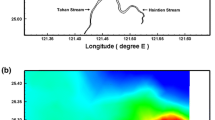Abstract
In this article, a three-dimensional primitive equation model is applied to Sado Estuary, which is a meso-tidal homogeneous estuary. Despite the homogeneity of its density field, the flow presents important vertical structures. This article shows that the common practice of using two-dimensional depth-integrated models in homogeneous estuaries can filter important vertical hydrodynamic features, such as secondary and circulating flows. The physical processes associated with these flows are analysed. The strong curvature of the channels and the strong bathymetry gradients were identified as the principal morphologic features of the estuary responsible for the generation of the flows. The model possesses a generic vertical mesh geometry approach, which is used to test the sensibility of the model to the vertical discretization when simulating these flows.
Similar content being viewed by others
References
Brogueira, M. J., G. Cabeçadas & C. Rocha, 1994. Sado Estuary coastal waters: thermohaline properties and chemical composition. In Revista de Geociências, 1. Simpósio sobre a margem continental ibérica atlântica 8: 23-25.
Bryan, K., 1969. A numerical method for the study of the circulation of the World Ocean. J. Comput. Phys. 4: 347-376.
Haney, R. L., 1991. On the pressure gradient force over steep topography in sigma coordinate models. J. Phys. Oceanogr. 21: 610-619.
Langerak, A., 1987. Secondary currents and their influence on depth-averaged (tidal) models. In IAHR Congress, Lausanne: 65-70.
Martins, F., R. Neves & P. Leitão, 1998. A three-dimensional hydrodynamic model with generic vertical coordinate. In Babovic, V. & L. C. Larsen (eds), Hydroinformatics'98. Rotterdam 2: 1403-1410.
Martins, F., R. Neves, P. Leitão & A. Silva, 2001. 3D modeling in the Sado Estuary using a new generic coordinate approach. Oceanol. Acta 24: S51-S62.
Mellor, G. L. & A. F. Blumberg, 1985. Modeling vertical and horizontal diffusivities with the sigma coordinate system. Mon.Wea. Rev. 113: 1379-1383.
Phillips, N., 1957. A coordinate system having some special advantages for numerical forecasting. J. Meteorol. 14: 184-185.
Vale, C., C. Cortesão & A. M. Ferreira, 1993. Suspended-sediment response to pulses in river flow and semidiurnal and fornightly tidal variations in a mesotidal estuary. Mar. Chem. 43: 21-31.
Wollast, R., 1979. Rio Sado, Campagne de measures dávril. Secretaria de estado do ambiente, Lisbon, Tech. Report.
Author information
Authors and Affiliations
Rights and permissions
About this article
Cite this article
Martins, F., Leitão, P. & Neves, R. Simulating vertical water mixing in homogeneous estuaries: [2pt] the SADO Estuary case. Hydrobiologia 475, 221–227 (2002). https://doi.org/10.1023/A:1020369431924
Issue Date:
DOI: https://doi.org/10.1023/A:1020369431924




